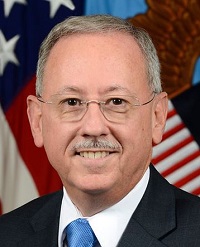Call for Action Made After Nuclear Posture Review
The U.S. Defense Department’s recently-released 2018 Nuclear Posture Review was the subject of a seminar at National Defense University's Center for the Study of Weapons of Mass Destruction on February 16.
 From a warfighter’s stance, the strategic environment has significantly evolved over the past two decades, said Air Force Gen. John E. Hyten, who delivered the keynote address at the seminar. The 2018 review is the Defense Department’s fourth review of U.S. nuclear policy, posture and programs since the end of the Cold War.
From a warfighter’s stance, the strategic environment has significantly evolved over the past two decades, said Air Force Gen. John E. Hyten, who delivered the keynote address at the seminar. The 2018 review is the Defense Department’s fourth review of U.S. nuclear policy, posture and programs since the end of the Cold War.
“Our adversaries are building and operating these strategic weapons, not as a science experiment, but as a direct threat to the United States of America.” He said the U.S. needs to have flexible capabilities that include a broad mix of modernized platforms to credibly deter the spectrum of adversaries and threats the nation faces.
The best way to prevent conflict is to be prepared for it, Hyten said - to be prepared to impose unacceptable cost and deny any benefit that any adversary may perceive. That, he said, is deterrence.
“Technology is constantly evolving. Adversaries are seeking to use these technologies to advance their own capabilities and put ours at risk. Hedging against an uncertain future means ensuring we're always ready, always confident, no matter what the future holds.”
That requires an agile, adaptable deployed force and a responsive infrastructure, which requires trained, educated men and women dedicated to the mission and postured for success, he said. It also means having the flexibility to adjust the force with new capabilities and acquire systems quickly. “What really worries me is this: I'm afraid our country has lost the ability to go fast,” the general said. “And, if we're to be successful in modernizing our capabilities to respond to this threat, it's going to require some big changes in the way we operate.”
The Department of Defense (DoD) budget, requirements, acquisition and testing processes are all too slow, he said. The solution, he said, is to get away from a culture that is risk-averse and empower people to move fast once again.
“First, we need a budget,” he said. “It's a critical enabler for everything else. I was encouraged last week, when Congress agreed to a defense budget framework that provides stable funding for the next two years. That would be huge.
“We also need to fix our requirements process,” he continued. “Why does it take years to build a set of requirements?” Hyten said DoD program managers in the acquisition process have to get approval for everything. “They're not authorized to make … any decisions,” he added. “You can't execute a program that way. So we have to give our program managers the authority and responsibility to move fast, and then hold them accountable.”
DoD also needs a test process that is efficient and also moves fast, he said, and operators need to understand how to take operational risk and be given the opportunity to do so when it comes.
“We need to empower commanders to take logical risk about how to employ weapon systems [and] how to accept weapon systems,” Hyten said. “Our modernization efforts will not be successful if we only address one of the issues. We won't solve the problem. We need to fix all of these things - budget requirement, acquisition, test, risk - if we're to make a difference.
“Signs of improvement are beginning to show,” he noted, but “we must move fast to respond to threats.”
Effective Deterrence

The review returns deterrence of nuclear attack against the U.S., its allies and its partners to the top priority of U.S. nuclear policy, he said. The review recommends two nuclear programs to strengthen U.S. capabilities to deter attack and assure allies: the modification of a small number of existing submarine-launched ballistic missiles to include a low-yield option and the pursuit of a nuclear sea-launched cruise missile. However, to strengthen deterrence, the review notes that the U.S. will consider the use of nuclear weapons only in response to extreme circumstances that threaten its vital interests.
“Effective deterrence is about tailoring our capabilities to a potential adversary's calculations regarding the use of nuclear force to ensure that it never can appear to be a useful option,” Trachtenberg explained. “We must assess our capabilities relative to the doctrine, exercises, statements, threats and behavior of potential adversaries. “If nuclear weapons are employed in conflict, it is because deterrence failed,” he said. “And the goal of the 2018 Nuclear Posture Review is to make sure that deterrence will not fail.”

that matters most
Get the latest maritime news delivered to your inbox daily.
Defense Secretary James N. Mattis recently told Congress that Russia is unlikely to give up something to gain nothing, he said. “Critics who favor eliminating U.S. nuclear systems in the face of what is clearly an expansive Russian nuclear modernization effort, I believe, are undermining America's greatest bargaining leverage and the prospects for future arms agreements,” Trachtenberg said.
“Much as we might prefer otherwise, nuclear weapons are a regrettable necessity in the real world,” Trachtenberg said. “After the slaughter of two world wars, [nuclear weapons] have prevented large-scale great power conflict for more than seven decades. This is not a trivial outcome. In an era of renewed great power competition, adversaries, allies and the American people should know that the United States has the will and the flexible resilient nuclear forces needed to protect the peace.”
